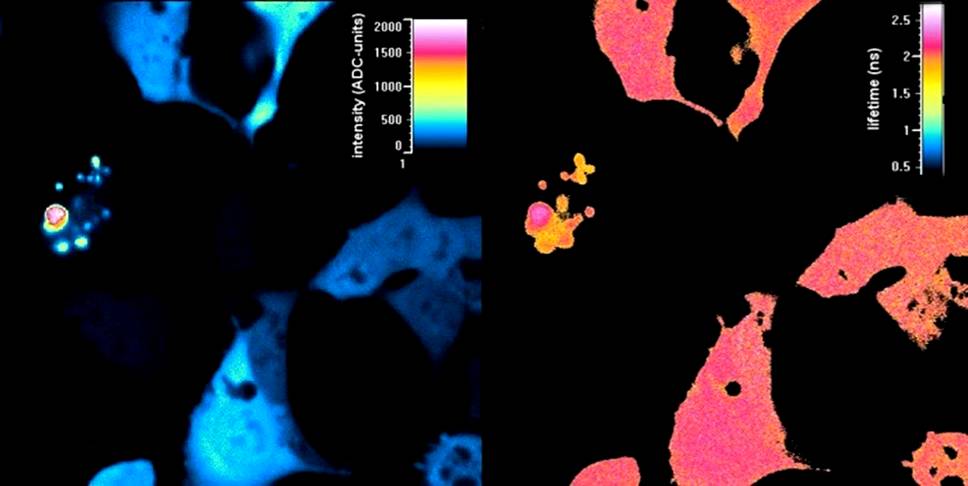C. Bartolacci1, M. Laroche1, H. Gilles1, S. Girard1, T. Robin2, B. Cadier2 et A. Buisson3
1Equipe Lasers, Instrumentation Optique et Applications (LIOA), CIMAP / ENSICAEN, 6 BLVD Maréchal Juin, 14050 Caen cedex,
2 iXFiber, rue Paul Sabatier, 22300 Lannion3 Laboratoire CI-NAPS, Centre CYCERON, Boulevard Becquerel, 14052 Caen cedex

As part of a multidisciplinary project of optical imaging of living cells, with chemists and neurobiologists of the CI-NAPS laboratory (CYCERON, Caen), the team “Lasers, Optical Instrumentation and Applications” (LOIA) of CIMAP has developed a new efficient and compact blue laser source for the excitation of the fluorescent protein. This breakthrough was made in collaboration with the company iXFiber in Lannion.
Optical imaging of living -or biophotonics- has undergone extensive developments over the last fifteen years. In particular, the advent of confocal microscopy and the discovery of new fluorescent probes like derivatives of the Green Fluorescent Protein (GFP) were used to access the three-dimensional visualization of biological processes at the cellular scale. This revolution is also the result of advances in photonics and laser technology.
However, few powerful laser sources are commercially available for advanced imaging techniques like fluorescence microscopy time-resolved FLIM (Fluorescence Lifetime Imaging Microscopy), a powerful tool for observing the dynamics of molecular processes and protein interactions within cells. Indeed, these techniques require specific laser sources in the visible range and sub-nanosecond or picosecond pulse duration.

The laser source developed at CIMAP is designed to effectively excite fluorescent proteins like the Cyan Fluorescent Protein (CFP) or the GFP. Its principle is based on a hybrid system including a semiconductor oscillator and an amplifier with neodymium-doped fiber. The laser pulses are generated by a 930 nm diode laser triggered by the gain and spectrally narrowed by feedback injection. These low energy pulses are then amplified in a double-clad optical fiber doped by Nd3 + ions.
Jointly with the iXFiber company, a major research effort was driven to design an optical fiber with an important amplification yield for the transition at 930 nm in Nd3+, involving three energy levels, naturally much less favorable than the well known transition around 1064 nm. The losses by formation of clusters of Nd3+ ions were pointed out and new chemical compositions of the doped fiber heart are under study [1].

To convert the infrared power in a blue beam, the amplified pulses are then frequency doubled in a MgO-LN congruent and periodically polarised crystal. This technology allows achieving pulse duration of 90 ps for a repetition rate of 43 MHz, compatible with fast FLIM imaging. The highest average power of 300 mW at 465 nm has been reached in a diffraction-limited beam [2]. This wavelength is particularly suitable for the excitation of GFP or CFP fluorophores.
The laser source has recently been installed in the platform imaging CYCERON (Caen) and preliminary tests have already validated its operation in a confocal microscope operating in time resolved fluorescence imaging (technical FLIM/FRET). Notably, the laser source was an opportunity to effectively excite the fluorescent protein CFP and simultaneously record images and fluorescence lifetimes in living cells HEK-293.
Contact: M. Laroche, H. Gilles (IRAMIS-CIMAP/LIOA)

References:
| •[1] Effects of ions clustering in Nd3+/Al3+-codoped double-clad fiber laser operating near 930 nm, C. Bartolacci, M. Laroche, T. Robin, B. Cadier, S. Girard, and H. Gilles, Applied Physics B 98 (2009) 317-322 |
| •[2] Generation of picosecond blue light pulses at 464 nm by frequency doubling an Nd-doped fiber based Master Oscillator Power Amplifier, C. Bartolacci, M. Laroche, H. Gilles, S. Girard, T. Robin, and B. Cadier, Opt. Express 18 (2010) 5100-5105. |


